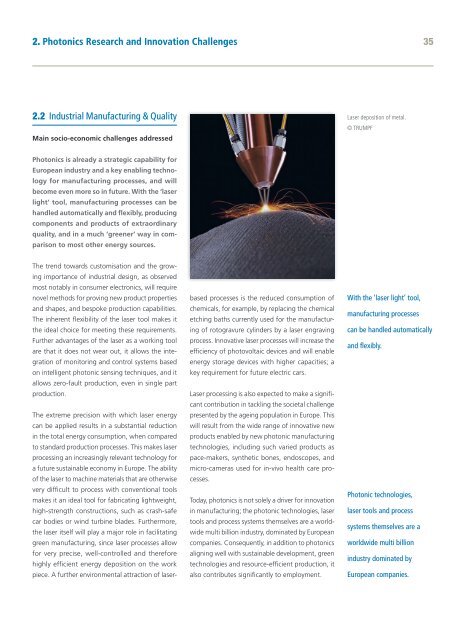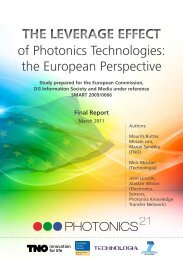Towards 2020 – Photonics driving economic growth in Europe
You also want an ePaper? Increase the reach of your titles
YUMPU automatically turns print PDFs into web optimized ePapers that Google loves.
2. <strong>Photonics</strong> Research and Innovation Challenges<br />
35<br />
2.2 Industrial Manufactur<strong>in</strong>g & Quality<br />
Ma<strong>in</strong> socio-<strong>economic</strong> challenges addressed<br />
Laser deposition of metal.<br />
© TRUMPF<br />
<strong>Photonics</strong> is already a strategic capability for<br />
<strong>Europe</strong>an <strong>in</strong>dustry and a key enabl<strong>in</strong>g technology<br />
for manufactur<strong>in</strong>g processes, and will<br />
become even more so <strong>in</strong> future. With the ‘laser<br />
light’ tool, manufactur<strong>in</strong>g processes can be<br />
handled automatically and flexibly, produc<strong>in</strong>g<br />
components and products of extraord<strong>in</strong>ary<br />
quality, and <strong>in</strong> a much ‘greener’ way <strong>in</strong> comparison<br />
to most other energy sources.<br />
The trend towards customisation and the grow<strong>in</strong>g<br />
importance of <strong>in</strong>dustrial design, as observed<br />
most notably <strong>in</strong> consumer electronics, will require<br />
novel methods for prov<strong>in</strong>g new product properties<br />
and shapes, and bespoke production capabilities.<br />
The <strong>in</strong>herent flexibility of the laser tool makes it<br />
the ideal choice for meet<strong>in</strong>g these requirements.<br />
Further advantages of the laser as a work<strong>in</strong>g tool<br />
are that it does not wear out, it allows the <strong>in</strong>tegration<br />
of monitor<strong>in</strong>g and control systems based<br />
on <strong>in</strong>telligent photonic sens<strong>in</strong>g techniques, and it<br />
allows zero-fault production, even <strong>in</strong> s<strong>in</strong>gle part<br />
production.<br />
The extreme precision with which laser energy<br />
can be applied results <strong>in</strong> a substantial reduction<br />
<strong>in</strong> the total energy consumption, when compared<br />
to standard production processes. This makes laser<br />
process<strong>in</strong>g an <strong>in</strong>creas<strong>in</strong>gly relevant technology for<br />
a future susta<strong>in</strong>able economy <strong>in</strong> <strong>Europe</strong>. The ability<br />
of the laser to mach<strong>in</strong>e materials that are otherwise<br />
very difficult to process with conventional tools<br />
makes it an ideal tool for fabricat<strong>in</strong>g lightweight,<br />
high-strength constructions, such as crash-safe<br />
car bodies or w<strong>in</strong>d turb<strong>in</strong>e blades. Furthermore,<br />
the laser itself will play a major role <strong>in</strong> facilitat<strong>in</strong>g<br />
green manufactur<strong>in</strong>g, s<strong>in</strong>ce laser processes allow<br />
for very precise, well-controlled and therefore<br />
highly efficient energy deposition on the work<br />
piece. A further environmental attraction of laserbased<br />
processes is the reduced consumption of<br />
chemicals, for example, by replac<strong>in</strong>g the chemical<br />
etch<strong>in</strong>g baths currently used for the manufactur<strong>in</strong>g<br />
of rotogravure cyl<strong>in</strong>ders by a laser engrav<strong>in</strong>g<br />
process. Innovative laser processes will <strong>in</strong>crease the<br />
efficiency of photovoltaic devices and will enable<br />
energy storage devices with higher capacities; a<br />
key requirement for future electric cars.<br />
Laser process<strong>in</strong>g is also expected to make a significant<br />
contribution <strong>in</strong> tackl<strong>in</strong>g the societal challenge<br />
presented by the age<strong>in</strong>g population <strong>in</strong> <strong>Europe</strong>. This<br />
will result from the wide range of <strong>in</strong>novative new<br />
products enabled by new photonic manufactur<strong>in</strong>g<br />
technologies, <strong>in</strong>clud<strong>in</strong>g such varied products as<br />
pace-makers, synthetic bones, endoscopes, and<br />
micro-cameras used for <strong>in</strong>-vivo health care processes.<br />
Today, photonics is not solely a driver for <strong>in</strong>novation<br />
<strong>in</strong> manufactur<strong>in</strong>g; the photonic technologies, laser<br />
tools and process systems themselves are a worldwide<br />
multi billion <strong>in</strong>dustry, dom<strong>in</strong>ated by <strong>Europe</strong>an<br />
companies. Consequently, <strong>in</strong> addition to photonics<br />
align<strong>in</strong>g well with susta<strong>in</strong>able development, green<br />
technologies and resource-efficient production, it<br />
also contributes significantly to employment.<br />
With the ‘laser light’ tool,<br />
manufactur<strong>in</strong>g processes<br />
can be handled automatically<br />
and flexibly.<br />
Photonic technologies,<br />
laser tools and process<br />
systems themselves are a<br />
worldwide multi billion<br />
<strong>in</strong>dustry dom<strong>in</strong>ated by<br />
<strong>Europe</strong>an companies.






